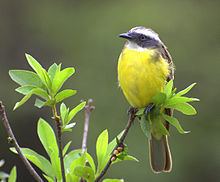Order Passeriformes Scientific name Myiozetetes Rank Genus | Phylum Chordata Family Tyrannidae Higher classification Tyrant flycatcher | |
 | ||
Lower classifications Social flycatcher, Rusty‑margined flycatcher, Grey‑capped flycatcher, Dusky‑chested flycatcher | ||
Myiozetetes similis social flycatcher bentevizinho de penacho vermelho
Myiozetetes is a small genus of passerine birds in the tyrant flycatcher family. The four to five species occur in tropical Central and South America. They are:
Contents
- Myiozetetes similis social flycatcher bentevizinho de penacho vermelho
- Social flycatcher myiozetetes similis
- References
The adult Myiozetetes flycatchers are c. 16–18 cm long and weigh 24-30 g. The upperparts are olive-brown, and the wings and tail are brown with only faint rufous fringes. The underparts are yellow and the throat is white. Young birds lack the red-orange crown stripe of the adult, and have chestnut fringes to the wing and tail feathers. The best distinction between the species is the head pattern: Vermilion-crowned, social and rusty-margined flycatchers have strong black-and white head markings like the great kiskadee, whereas grey-capped and dusky-chested flycatchers have greyish heads, with a short weak eyestripe in the former.
Myiozetetes flycatchers sally out from an open perch in a tree to catch insects in flight. They sometimes hover to take small berries. They breed in cultivation, pasture, and open woodland with some trees, building a large roofed nest from stems and in a bush, tree or on a building. The nest is often constructed near a wasp, bee or ant nest, or the nest of another tyrant flycatcher. The nest site is often near or over water. The typical clutch is two to four brown or lilac-blotched cream or white eggs, laid between February and June.
